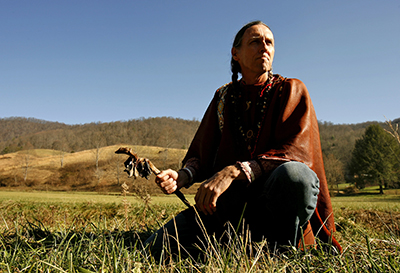One night last summer, Terry Shinn visited my family's campsite next to the French Broad River, in the Blue Ridge Mountains. The tall, soft-spoken stranger lived just up a short path, in the faded old river village of Barnard, a mile from the Walnut community.
Shinn told us that he is part Cherokee, part Seneca and mostly Irish, but has long been what he calls a "keeper of stories." That night, we sat by the fire and he enthralled us with Native American stories about Squirrel and Bear, the origin of bats and the magical healing powers of butterflies.
He also told us a local historical story. "The old man that told me this story said that it came from his grandpa, " Shinn told us. "It is a hard story for me to tell, " he warned my children, "but I think it is an important story for you to hear."

Here in Madison County there are two little roads, Upper Brush Creek and Lower Brush Creek, not far from here. Upper Brush Creek Road goes up into a mountain cove, and at the top of that mountain is an outcropping of rocks that the local people today call High Rock. This is a story about High Rock. A couple hundred years ago, how far back I am not sure, there was a Cherokee village near Walnut, close to where the BP station is now. And in the field behind the village, where there is a middle school and an elementary school today, the Cherokee raised corn and other crops. It was a small village. They were hunters and farmers, and they had lived here in these mountains for centuries. They were peaceful. They lived basically in harmony with the early settlers. The Cherokee lived in this area because the hunting was very good, and the land was very fertile and it was flat there, where they could grow their corn fields. Corn is what got the people through the winter months when game was very scarce. Now, in the 1830s, Andrew Jackson, who was president of the United States in those days, put out a decree that all these Indians would be rounded up and sent out to Indian Territory, which is now Oklahoma. It was called the Indian Removal Act. There was a detachment of military near Bryson City, and they had a stockade there, a large stockade, to house the Cherokee. It held thousands. The soldiers found out that there was this small village of Cherokee up here near Walnut, North Carolina. They sent a detachment of military to arrest the people, so they could be marched out to Oklahoma on what was known later as the Trail of Tears. They came up to this little Walnut community near Brush Creek, and they found the people working in the cornfields. They arrested all of the people and put them in ropes and bound them. They were not allowed even to go to their village to get a blanket or an extra pair of moccasins or any personal effects, nothing. They were herded between the horses and forced to march back to Bryson City. I said everyone was in the cornfield. Actually, there were three women on a high hill overlooking the field. In terror, I am sure, they watched their family and friends be arrested and marched away. The reason that they were not working in the fields is because they had small babies. They watched and they became very determined not to go with these white soldiers, but to stay and live. So they stayed hidden in the hills. After their people were led away, the women came out of the hills. They realized that, for them to live there by themselves, they would have to farm and hunt. But they had no baby sitters. They needed to do something with those children so that they could farm and gather nuts, berries and other food in the daytime. They came up with an idea. They went up onto High Rock with those children, up at the head of Brush Creek on the mountain there. There were some large cut-outs, washouts, in the rocks. They soon found out that they could put their children safely down inside these rocks. It was too steep for the children to climb out of, and it was also a place where animals could not get into. The children would be safe there. The women could work the fields from daylight to dark, and they could return to their children at night. This went on for most of the summer. The children became stronger. The cornfields were healthy. But somehow the military found out that there were still some holdouts up there, and they sent a small patrol back. When the soldiers got there, they found the women working in the fields. They arrested them and tied them up and treated them very harshly. They put them on horseback, and they led those women away. Now, the women, who spoke only Tsaligi -- Cherokee -- tried to tell the soldiers that they had small babies up in those rocks. But the soldiers spoke only English. Either they did not understand or they did not want to understand. They made them go to Bryson City, and those children were left in the rocks. To this day, you can talk to the old people, and even some of the younger ones, that live in and around Walnut and Brush Creek. They will tell you that, on a summer evening when there is no wind, if you go out on your porch and listen, you can still hear those babies crying.
Trail of Tears
The Indian Removal Act of 1830 forced more than 70,000 Native Americans out of the Eastern United States. That number included 17,000 Cherokee. An estimated 4,000 Cherokee died of cold, hunger and disease during the journey to Oklahoma.